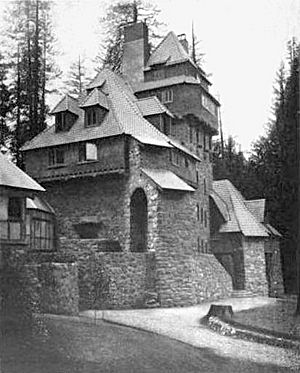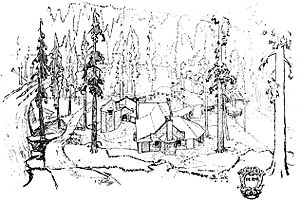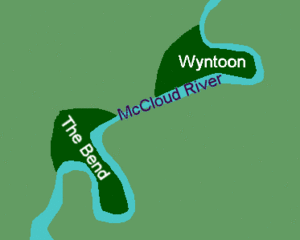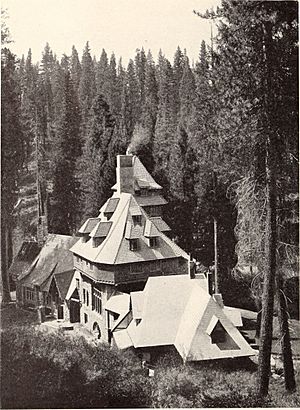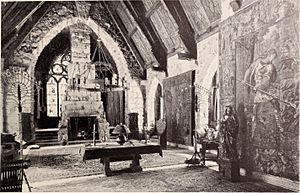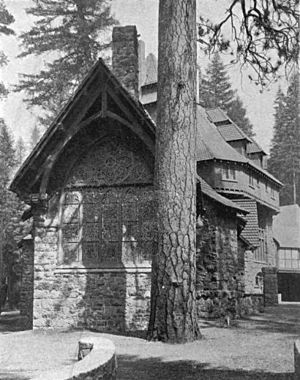Wyntoon facts for kids
Wyntoon is a large private estate located in a quiet, natural area of Siskiyou County, California. It's owned by the Hearst Corporation. Many famous architects like Willis Polk, Bernard Maybeck, and Julia Morgan designed buildings for Wyntoon, starting way back in 1899.
The land where Wyntoon sits has two sharp bends in the McCloud River. It was named by a financial advisor, Edward Clark, after the local Native American tribe, the Wintun people. Wyntoon started as a simple fishing spot. Over time, different people improved the land, especially San Francisco lawyer Charles Stetson Wheeler, his client Phoebe Hearst, and her son William Randolph Hearst. Many amazing buildings, known for their design, were built here. Some were destroyed by fire, and other huge, expensive buildings were planned but never built. Famous people like Clark Gable, Charles Lindbergh, and John F. Kennedy have visited Wyntoon.
Contents
Early Fishing Spot
The first people known to live in the Wyntoon area were the Winnemem Wintu tribe of Native Americans. They are a part of the larger Wintun people.
In the 1880s, a man named Justin Hinckley Sisson, who loved the outdoors, came to this area. He opened a hotel, restaurant, and tavern near Mount Shasta. He worked hard to get a railroad line built from Redding to his location, and he succeeded! The railroad was finished in 1887. It brought many people, including miners, hunters, and tourists.
Sisson bought a lot of land, including the area that would become Wyntoon. He built a fishing resort about 16 miles away on the McCloud River. It was very popular with hunters and fishermen and became known as "Sisson's-on-the-McCloud." Justin Sisson passed away in 1893.
Charles Wheeler's Hunting Lodge
In 1899, Justin Sisson's wife sold the McCloud River fishing resort to Charles Stetson Wheeler. He was a rich lawyer from San Francisco. Wheeler named his property the Wheeler Ranch. He built a large hunting lodge on the river at a spot called Horseshoe Bend. Its first stone was laid in 1899.
The lodge was designed by San Francisco architect Willis Polk. It had stone walls and a slate roof. It even had a special "fish tower" with two windows that were actually aquariums filled with local trout! A Latin saying over the entrance meant "a temple to fishing." Polk's design was shown in a magazine in 1899 and was known for its "Shingle Style" architecture. The building curved along the river, creating a beautiful courtyard. The dining room had great views of the river, and there was a porch that led down to a gazebo right over the water. The inside felt like a medieval estate with huge fireplaces. The stone and wood used made the building blend in with the natural beauty of the land.
The Wheeler family spent many summers at the ranch. In 1900, Wheeler invited his client, Phoebe Hearst, to visit. Hearst loved the land and wanted to buy it, but Wheeler said no. However, they made a deal: Hearst could lease part of the land for 99 years. She also bought land next to it from her financial advisor, Edward Clark, who called his property Wyntoon. Phoebe Hearst then used the name Wyntoon for all the land she had. In 1901, she decided to build a huge, seven-story house there. Wheeler was not happy because they had agreed her building would be small, but he didn't stop her.
Wheeler kept the part of Wheeler Ranch that he didn't lease to Hearst. After Wheeler died in 1923, William Randolph Hearst (Phoebe's son) bought Wyntoon completely in 1929. In 1934, he bought all of Wheeler Ranch and The Bend, making his property a huge 50,000 acres.
Phoebe Hearst's Castle
After signing the lease, Phoebe Hearst decided to build a very grand home. She hired Bernard Maybeck to design it like a Gothic castle from the Rhine River in Germany. The castle was mostly finished in 1902 and cost Hearst $100,000. Maybeck also hired Julia Morgan to help with the design.
The castle was built to fit the hillside and a group of six tall trees. It was 120 feet long and 56 feet wide. A central stone tower reached 75 feet high. It had six floors of bedrooms, each entered from a stone spiral staircase. The outside of the tower had thick walls and a very steep roof to hold heavy snow. The roof was covered with green tiles from the Netherlands, which looked like the misty colors of the forest. Bluish-gray volcanic stone from local areas was used for the strong, massive walls.
The living room was huge, 80 feet long and 36 feet wide. It had a stained glass window that was a copy of one from a 13th-century church in Germany. The ceiling was 36 feet high, with steeply angled wooden beams resting on thick stone walls. There were two large fireplaces in the room. Tapestries hung from the stone walls, giving it a medieval feel.
Maybeck also designed a dining hall similar to the living room, with Gothic stone walls and a high, peaked roof. The kitchen wing was connected to the dining room. Phoebe Hearst also built other buildings, including "The Gables" for extra guests and a "Honeymoon Cottage." The castle was finished in 1904 and featured in magazines.

Hearst spent her summers at Wyntoon and often took care of her son's children there. Her son, William Randolph Hearst, had five sons, and they all spent summers at Wyntoon with their grandmother. Phoebe Hearst sometimes invited her friends to Wyntoon as well. When she passed away in 1919, she left Wyntoon to her niece, Anne Apperson Flint.
Anne Flint and her husband moved in. During this time, architect Julia Morgan designed four more buildings for Wyntoon. These included a home for the superintendent, separate living quarters for staff, a stables building, and a "Swiss Chalet" for higher-ranking staff.
William Randolph Hearst's Plans
William Randolph Hearst was very upset that his mother left Wyntoon to his cousin, Anne Apperson Flint, instead of him. After several years of talks, he bought Wyntoon from Flint in 1925 for $198,000.
In the winter of 1929–1930, Maybeck's beautiful Wyntoon castle burned down, possibly due to a kitchen fire. Time magazine reported that Hearst lost a lot of money and some of his art collection. In early 1930, Hearst asked Julia Morgan to design an even bigger castle to replace it.
Morgan worked with her old teacher, Maybeck, on plans for a huge, eight-story Bavarian Gothic-style castle. It would have two large towers and many smaller ones, with about 61 bedrooms. Hearst even tried to buy old stonework from buildings in Spain to make Wyntoon look ancient. He bought a 700-year-old monastery called Santa Maria de Ovila. The monastery was taken apart and shipped to San Francisco, costing about $1 million.
Hearst also thought about using parts of an old barn from England, which he had shipped to California, for his new castle. In 1931, Morgan showed Hearst several designs. One idea was to build an indoor swimming pool using the stones from the old Spanish monastery's church! The pool would be 150 feet long, with changing rooms in the old side chapels.
However, in July 1931, Hearst stopped all his big construction plans. The Great Depression had severely reduced his money, and he couldn't afford the huge Wyntoon project while also building his famous Hearst Castle in San Simeon.
Instead of a massive castle, Hearst asked Morgan to design a "Bavarian Village" with many buildings that looked like medieval German or Austrian homes. Hearst sent Morgan to Europe to study these types of buildings. In 1932, Morgan created a master plan for Wyntoon. It included guesthouses with fun names like Cinderella House, Fairy House, and Bear House. These three-story buildings with steep roofs were finished in 1933. Artists added beautiful carvings and paintings of fairy tales, making them bright and cheerful.
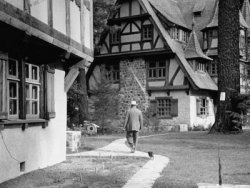
Downstream from the Bavarian Village, Morgan's plan included fun activities like a swimming pool, tennis courts, and a croquet lawn. There was also a dining hall called "The Gables" that could show movies. While San Simeon could host about 30-50 guests, the expanded Wyntoon could fit 100 people for a weekend.
In 1934, Hearst bought all of Wheeler Ranch. Polk's old building, "The Bend," was mostly torn down, except for one part. The rest was redesigned by Morgan in a Gothic Revival style and rebuilt from 1935 to 1941, using many of its original stones.
In 1935, Life magazine published photos of Hearst relaxing at Wyntoon. The photos showed Hearst's communications office, which was the "nerve center" of his publishing business. It had operators working 24/7 to manage telegraph and telephone calls.
By mid-1937, Hearst faced financial difficulties and had to give control of his properties, including Wyntoon, to a group of trustees. They cut his costs and stopped many smaller projects. Wyntoon was kept with a small staff. Hearst hosted fewer guests after this. From 1938 to 1940, many of Hearst's art collections, including items from Wyntoon, were sold.
After the attack on Pearl Harbor in December 1941, Hearst moved to Wyntoon with his partner, actress Marion Davies, because San Simeon was too close to the ocean. They lived in Bear House by the river with their pet dachshunds.
The snow melts on the mountain
And the water runs down to the spring,
And the spring in a turbulent fountain,
With a song of youth to sing,
Runs down to the riotous river,
And the river flows to the sea,
And the water again
Goes back in rain
To the hills where it used to be.
And I wonder if life's deep mystery
Isn't much like the rain and snow
Returning through all eternity
To the place it used to know.
During their time at Wyntoon, Hearst and Davies had fewer visitors because it was more remote. They spent a lot of time together. Hearst wrote Davies a poem or a short note every night. Over the winter of 1943–1944, Wyntoon hosted guests like actor Clark Gable, film directors, and even Joe Kennedy with his 26-year-old son "Jack", who later became president. Jack surprised everyone by swimming in the freezing McCloud River!
Wyntoon Today
In 1943, Hearst's trustees reorganized the Hearst Corporation. Under new leadership, Wyntoon was made profitable. The large property, totaling about 67,000 acres, was used for logging and replanting trees. This operation made about $2 million annually by 1959.
In the late 1980s, architects began working on Wyntoon again. They finished the inside of "Angel House," which had been stopped in the 1930s. They also remodeled a part of Polk's original "The Bend" building. Another main part of "The Bend" burned down in 1992, and the architects were hired to rebuild it. They used local stone, ironwork, and old fireplaces to match the original style.
Today, Wyntoon is still owned by the Hearst Corporation and is not open to the public. It is located north of Lake McCloud and east of Dunsmuir, California. If you are an adventurous kayaker, you might be able to see parts of the estate from the Upper McCloud River during spring when the snow melts.
The estate has a special legal right to use an unlimited amount of water from the nearby McCloud River.
See also
 In Spanish: Wyntoon para niños
In Spanish: Wyntoon para niños


